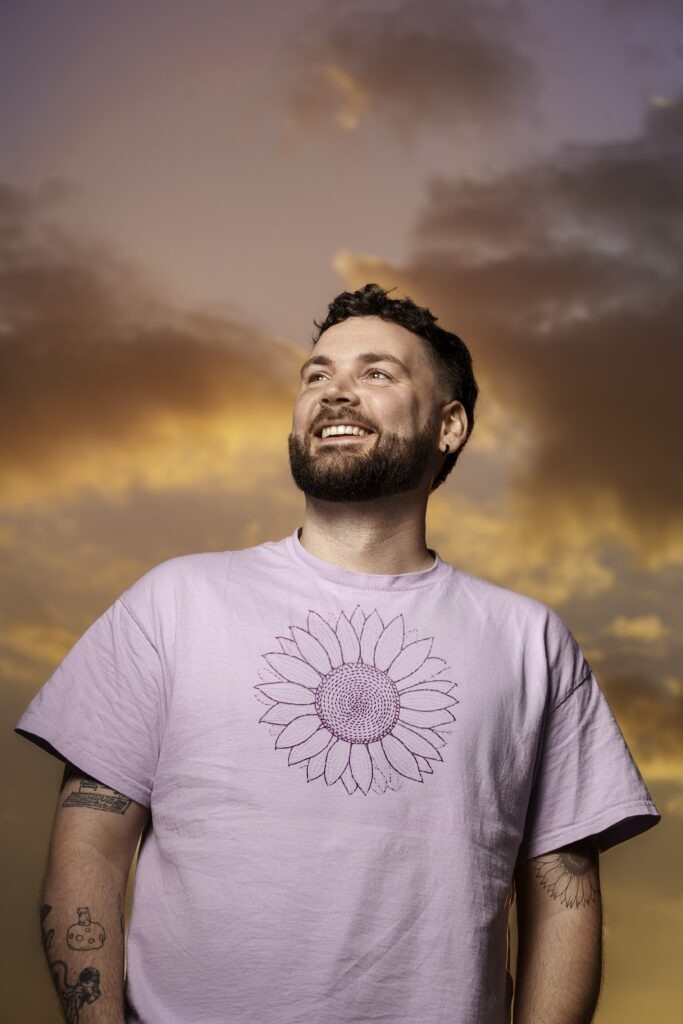
Thomas is a teacher and musician who lives with ADHD. Instead of seeing it as a problem to fix, he shares how his perception of ADHD has shifted for himself: “I don’t say illness anymore. For me, it’s simply a situation… a way that I am today, how my brain is configured.”
Thomas got lucky—doctors diagnosed him early, around age seven or eight, and he had what he calls “a fantastic support system.” His parents took his early signs seriously and quickly found professional help. But it took years for him to fully understand what ADHD meant in his everyday life.
The Early Challenges
As a child, the concept was bewildering: “It was a really strange concept for me. I was told ‘you can’t concentrate very well,’ and that was ADHD for me.” People focused only on the narrow view—school performance, sitting still, paying attention in class.
His journey with medication began with the typical first choice: Ritalin. It failed terribly. “I got tics, I got quirks. I started making faces, twitching. My mum says I became really badly depressed as a child.” They switched to a slow release (also called long-acting) version that had fewer side-effects and worked better overall, though he notes the childhood dose would make him “a complete zombie” today.
He also got support to manage ADHD symptoms around estimating time and distances, but at school he still required medication for exams and memorisation: “ADHD means you can read a page a hundred times, and if you are not interested it just won’t stick. I often had to literally turn my study-material into a song, stories, anything just so it can be interesting-enough.”
Understanding the Full Picture
For Thomas this means recognising that ADHD goes far beyond concentration problems in class. It connects to his impulsivity, the intense emotions he feels in both good and bad moments, his struggles with time management, and what he calls the everyday moments “where I deviate a bit.”
A turning point came during university when he encountered a course listing ADHD symptoms in two columns—negative and positive. “Up to that point, I never thought there could be a list of positives.” The positive traits included creativity, sense of justice, strong empathy, and rapid problem-solving: “You’re quicker with jokes, good ideas come instantly, you see solutions quickly because you don’t follow that linear thread and explore any issue from many different perspectives at once.”
Navigating Medication and Growing Up
Thomas directly tackles the heated medication debate: “Some people are so extreme—’it’s all in your head, you don’t need medication.’ But ADHD means you want to do something but then can’t get yourself to act on your intention. You become so fed up that you just can’t get it together, and yet you’re not stupid… it can take you to some dark places and medication helps, it unlocks this barrier.”
He’s pragmatic about the role of medication: “It’s not a magic potion that suddenly makes you a superbrain able to do anything, but it gives you more focus, sometimes a bit of tunnel vision, and simply helps you concentrate.” Thomas found medication essential for succeeding “in an education system where you have to do things you don’t necessarily like, where your strengths aren’t valued or appreciated.”
“In the end, ADHD is a deficiency in the brain, your neurons don’t work properly. We don’t make this up—why would we?” For many with ADHD, medication isn’t just helpful—it’s medically necessary treatment for a neurological condition, similar to insulin for diabetes. The ADHD brain has a number of structural and functional differences, particularly in regions related to executive function, attention, and impulse control. One key challenge lies with how the brain forwards signals between neurons because it can’t produce enough dopamine, which is why medication can be so important to help the brain function ‘properly’. Of course, the right dosage and type of medication can take time to identify.
“Now, as an adult, I know much more—ADHD is much broader, and it impacts many different parts of my life in different ways.“
Hidden Struggles 1: Perceiving Time
One of Thomas’s biggest challenges involves what he calls “time blindness”—the difficulty of accurately feeling, estimating, and managing time. “I couldn’t sit here for an hour and after an hour say, that was an hour. Never. One time I’d think it was half an hour, another time I’d think it was three hours.”
This creates cascading problems with planning and organisation. “You simply don’t have that feeling for time passing… You always have to build bridges” using reference points from past experiences. The result? Either extreme over-preparation (arriving three hours early for flights) or last-minute panic when time estimates prove wildly optimistic.
Hidden Struggles 2: Appearing “Normal”
Like many with ADHD, Thomas has learned to hide (mask) his struggles on the outside, but this takes a toll. The internal experience—constant mental activity, emotional ups and downs, executive function challenges—remains invisible to others while consuming enormous mental energy.
“I am sometimes still ultra annoyed with myself, where I am like, ‘oh, man’ at the end of the day,” Thomas admits. The pressure to perform or act normal in social and professional settings creates a dual burden: managing ADHD symptoms while simultaneously hiding that effort.
His academic ambition exemplifies this strain: “I am quite ambitious. For me it was like, either be the best or let it be. Or at least I want to be able to keep up with the best. But my brain isn’t designed to be able to keep up unless I can use a crutch (medication).”
This gap between ability and performance creates frustration. “It’s not about my cleverness, it’s simply about my ability to stick with it.” Thomas explains. ADHD’s central challenge is usually not intelligence but consistent self-regulation and applying one’s skills over time.
The constant monitoring and adjustment depletes mental resources, creating what some call “the ADHD tax”—the extra effort needed to achieve what seems effortless for others. As Thomas puts it: “You’re in your own head thinking and having racing thoughts the whole time. You go, ‘oh, am I smart enough, am I pretty enough, am I fast enough,’ whatever. You can never really switch off and doubt or reevaluate things.”
Relief comes only during engagement with meaningful challenges: “When you have something that interests you, then you’re like, bam, focus… you’re not in your own head, you’re on the problem and can go for hours without a break.”
How to do ADHD Travel
Travel amplifies many ADHD challenges, but Thomas has developed specific strategies through trial and error that can even help people without ADHD.
He learned at age eight that packing must become a systematic process, sharing what he was taught after diagnosis and still uses today: “You go from top to bottom. You literally start with your head and then you’re like, okay: do I need a hat, cap, sunglasses, cream for your skin, toothbrush, toothpaste… You scan everything once, and then you know, my body is taken care of.”
Airports can be manageable, but not always: “There’s so much stimulation at a busy airport,” Thomas explains. His effective coping strategy when traveling alone is “When I’m alone—lock in, headphones, noise cancelling, just block everything out.”
But this strategy becomes unavailable when traveling with others: “If I have a person with me, it’s usually over.” It is the competing demands on limited cognitive resources—social interaction requires Thomas to remain present and responsive, preventing him from using his primary sensory management technique. The social demands consume the mental resources he would otherwise dedicate to processing and filtering the overwhelming sensory environment of a busy, loud, and bright airport. At worst, a vacation before going on vacation becomes necessary.
When he can’t rely on his coping strategies and is exposed to the full sensory assault: “It’s like, ‘oh no, can it be quiet for once?’ You are simply completely overstimulated.”
Managing essentials requires physical systems: “I constantly check if I have everything—do I have my wallet, phone, keys? The whole time, the paranoia.” His solution: “What I really like are bum bags. You have everything on your chest in one thing—phone, wallet, keys, documents. You just have to watch out for this one thing.“ For planning itself, Thomas recommends radical simplification: “Do everything in advance so that your mind has to think about as few things as possible. No decisions. You just gotta be able to go with the flow.”
Addressing Misconceptions
Thomas tackles the perception that “everyone has ADHD now” with nuance: “Most people only seek diagnosis after they’ve been suffering for a while. Usually when you have ADHD, you get the diagnosis because you’ve suffered from it. But once you have the diagnosis and know ‘okay, I have that,’ then you can work on it.” ADHD runs strongly in families, and with better referral systems for diagnosis in childhood compared to just 10-20 years ago, the number of people diagnosed with ADHD has increased, even though many adults with ADHD remain undiagnosed.
His message to those without ADHD is straightforward: “You just have to accept at some point that it’s a real thing. A person who has ADHD won’t bother you with it, hopefully. But if someone tells you they have ADHD, then take it seriously.”
Thomas’s Advice
For others with ADHD, Thomas suggests focusing on strengths while managing challenges: “Look for the positive sides and strengthen them. Instead of dragging yourself down because you have that and ‘ah, I can’t concentrate,’ work on it and stay strong.”
He acknowledges ADHD’s ongoing nature: “Certain things don’t go away. You have more tendency towards depression, you have more tendency towards addictive behaviour… But you can work on things. You can get help. And above all, you should push the positive sides and strengthen them.”
Living Authentically
Despite the challenges, Thomas has found a way to thrive: “I am who I am because of ADHD. I would never be like this, I would never have done what I did, without ADHD. I wouldn’t have the friends I have, wouldn’t have all this creativity and achieved the things I did.”
His perspective offers hope: “I think it’s absolutely possible, even with ADHD, to lead an incredibly happy life. Even happier than other people without ADHD, perhaps.”
Bonus: ADHD and Relationships
Thomas credits much of his success to his support system, particularly his partner, who plays a unique role in his relationship with travel. He explains the fundamental difference in their approach to exploring the world: “My partner has absolutely had an influence on travelling, because she loves travelling immensely, and that is ultra important for her. She sees much of the meaning of life in travelling. And for me, I love travel but can also be content chilling a bit, being cozy at home, being in my little nest.”
“I think a partner can help you to get out of your comfort zone. And if they also show patience, are friendly with neurodivergent people and the realities that come with dating someone neurodivergent… especially with ADHD this really, really helps so much.”
What’s particularly valuable is how she helps him recognize blind spots in his self-assessment: “My partner definitely showed me there are things that are good for me, that I simply don’t do, because they are not in my comfort zone.” Thomas acknowledges that while he might eventually push himself to travel, “She actually does it, you know what I mean?” – bridging the gap between intention and action that many with ADHD struggle with.
The relationship ultimately links emotional safety, structure, encouragement, and accountability to growth opportunities. “It helps immensely for your mental health when you know you can mess up, you can be really difficult, and that person sees you for the positive things and not for all the sh*t that you do when ADHD took over.”



